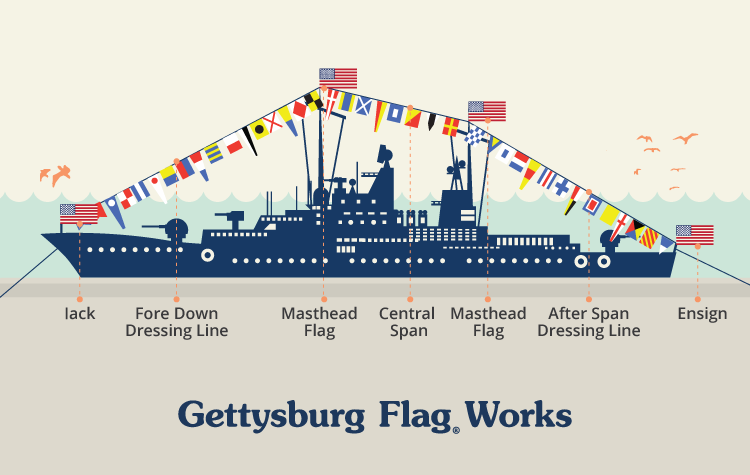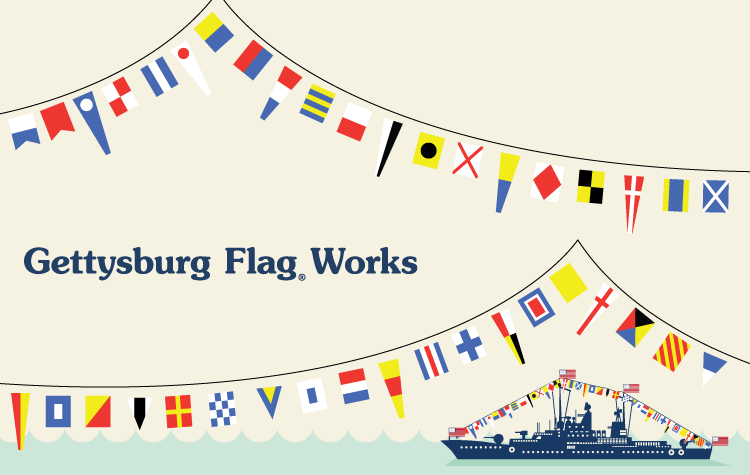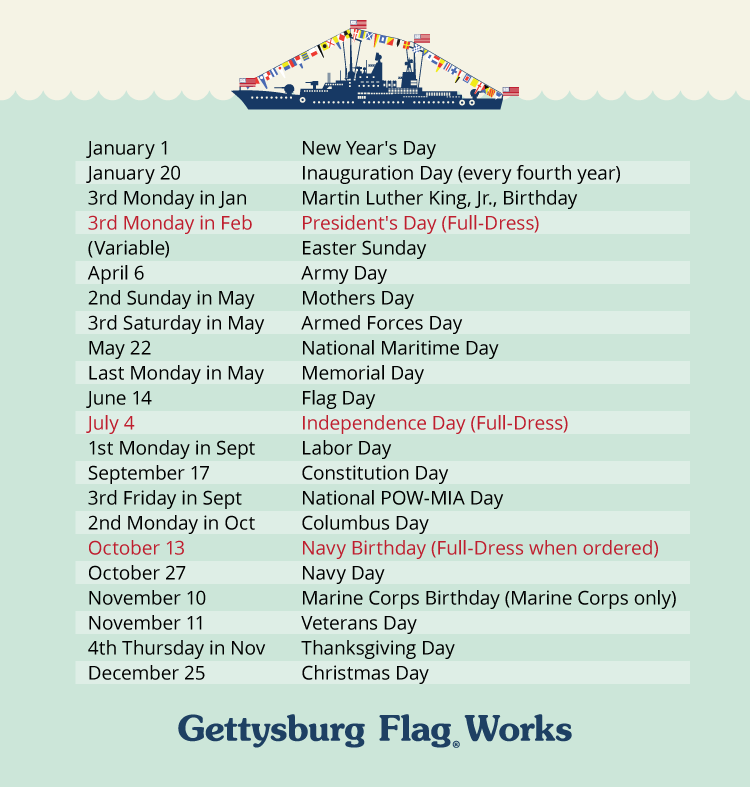Dressing Ship with Nautical Flags
If you’ve ever attended a regatta or other large boating event, you’ve probably noticed that the ships are adorned with brightly colored boat flags that are both beautiful to look at and that convey U.S. and international codes and signals. The nautical signal flags you see flying from the masts are carefully selected based on their meanings and are raised following strict protocol.
Anatomy of a Dressed Ship

A ship is considered “dressed” when the largest national ensign assigned to the ship is flown from the flagstaff with a national ensign displayed at each masthead. National ensigns at the masthead must be of uniform size, except if there is a substantial difference in the heights of the mastheads.
Stretching down from the masthead is a rainbow of nautical signal flags that reach all the way to the foot of the jackstaff, and then to the foot of the flagstaff. When the boat flags are displayed in that way, the ship is considered fully dressed. Usually, a ship is dressed from stemhead to masthead, masthead to masthead and then to the taffrail. A ship need not be dressed with an array of signal flags as long as it has an ensign flying from each masthead.
Types of Nautical Signal Flags and Associated Customs
Boat flags are much more than simply for decoration. There are some flags that have universal meaning in international waters, and they might let other sailors know a ship’s purpose, warnings or even be sending distress signals. For example, the “alphabet” flags have meanings that include B (Bravo), which indicates that the ship is taking on or discharging explosives; F (Foxtrot), which means that the ship is disabled and requests that another ship communicate with the crew; M (Mike), which lets other seamen know that there is a doctor on board; W (Whiskey) which means that a member of the crew or a passenger requires medical assistance; Y (Yankee) which indicates that the vessel is dragging its anchor, and others. Even NATO uses these same flags alone or in short sets to communicate unclassified messages.
Traditionally, the nautical signal flags are made up of 26 square flags (the alphabet flags), 10 numbered pendants and three substitutes (or “repeaters”). Flags only come in red, blue, yellow, black and white because those are the most easily recognizable colors at sea.
In What Order Should Boat Flags Fly?
Sometimes a navy will prescribe a specific flag order for a war ship in order to ensure that there are no hidden meanings conveyed or interpreted by the order of the flags. Also, some navies like to have uniformity in the appearance of their ships. However, in most cases, a seaman selects the order of his flags only to evenly distribute the flag colors, but without a specific order, theme or purpose. Often, there is a deliberate avoidance of possible flag order because the crew does not want the flags to be interpreted as signaling a particular message. Since there are twice as many alphabet boat flags as there are pennants, most ships will display two flags, one pennant, two flags, one pennant, and so on.
Often, the number of flags flying will send a message to other ships. For example, two-flag signals indicate distress or maneuvering; three flags could mean compass points, relative bearings, general code and decode signals and others; four flags show geographic signals, ship names, bearings and similar signals.
How to Dress a Ship

On a celebration day or other day when you’re planning to dress ship, you would begin at eight o’clock in the morning when the ship is at anchor (unless it is the ship’s maiden or final voyage, which are the only times when a ship should be dressed at sea). The national ensign should be hoisted at the stern staff, and then the rainbow of nautical signal flags from the international code is arranged from the water line forward to the water line aft by using the stem or bowsprit end and the masthead. Here’s one example of a sequence (as pictured above) that would provide a nice color pattern, though it is not required:
AB2, UJ1, KE3, GH6, IV5, FL4, DM7, PO Third Repeater, RN First Repeater, ST Zero, CX9, WQ8, ZY Second Repeater
When to Dress Ship
Dressing ships usually takes place on national holidays, at regattas and on other special occasions. An anchored ship may be dressed at 0800 hours (or eight in the morning) and remains dressed until the evening. If it’s a vessel’s maiden or final voyage, or if it is participating in a marine parade or similar event, then the dressing could accommodate those situations.
If a ship is firing a salute to honor the president or a former president, or in honor of a U.S. national anniversary like Presidents’ Day or Independence Day, the U.S. national ensign is flown at the head of the main mast. If the salute is to honor another country or a foreign dignitary, that country’s ensign is flown.
The days when it is customary to dress ship and fly holiday colors are as follows:

International Dressing Ship Customs
When you are visiting a foreign port or traveling in foreign waters, it’s customary to display a courtesy flag, which is the civil ensign of that country. By the same token, the USPS (U.S. Power Squadrons) and U.S. yacht ensigns should not be worn in foreign waters. Even a mastless vessel can display this courtesy by wearing the courtesy flat at the bow or on a starboard antenna.
Customs in foreign waters do vary, so if you’re planning to sail in foreign seas, it’s best to learn the correct procedure for the waters in which you’ll be traveling. Some countries expect that foreign vessels only fly the courtesy flag after the quarantine flag (the yellow “Q” nautical signal flag) has been lowered and the vessel is granted license to enter by that country’s officials. When you return to U.S. waters, lower the foreign courtesy flag. It’s not a “badge” or showing of accomplishment for having visited overseas. However, if you have a foreign guest sailing on your ship, you may display the ensign of that person’s country from the bow staff or outboard port spreader. Be sure that if you’re going to fly a courtesy flag, you’re sure that you’ve hoisted it properly. If the flag is upside down or in the wrong position, citizens of that country could find it very offensive!
There are also regional courtesy flags. It’s important to know the local customs before you visit. Some French regional flags are traditionally flown above the French ensign, yet the Catalan flag is flown below the Spanish ensign. So, the best way to approach foreign waters is to do your research ahead of time so that you’re aware of the specific nuances of the territory.
Sources:
http://www.maineharbors.com/flag.htm
https://www.marinewaypoints.com/learn/flags/flags.shtml
http://www.navy.mil/navydata/nav_legacy.asp
http://www.beaufortonline.com/nautical-flag-guide/
http://www.sailorschoice.com/seamanship/number_pennants.htm
http://www.usps.org/f_stuff/etiquett.html#dressing-ship
http://www.seaflags.us/customs/customs.html
http://www.usps.org/f_stuff/etiquett.html#dressing-ship
http://sailingalmanac.com/Almanac/Reference/flagabroad.html

Hey Mike:
Long time no see. One more thing :
On a sailing vessel, the National Ensign is normally flown either from a stern staff or on the leech of the aftermost sail, approximately 2/3 of the way up, or at the top of the aftermost gaff on a gaff rig boat.
I didn’t realize there were so many conventions to follow when displaying signal flags on a ship. It’s important to know the proper conventions so that you communicate the correct things to other boats. I think it’s interesting to find out what these different flags stand for as it gives us an insight into a different method of communication at sea.
I have a dozen flags that I picked up at a yard sale. I have found that 4 of them match up as letter flags, but the rest don’t seem to have any meaning. Should each signal flag have a specific meaning?
If its a specific letter flag, it does not necessarily have a meaning other than its corresponding letter (although some of them do, not all of them do).